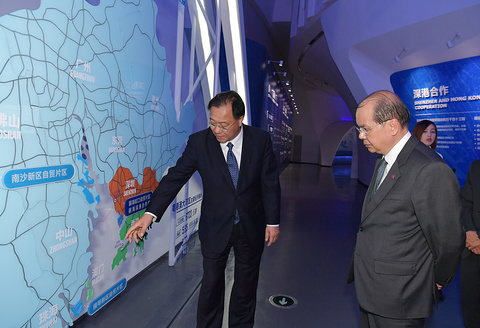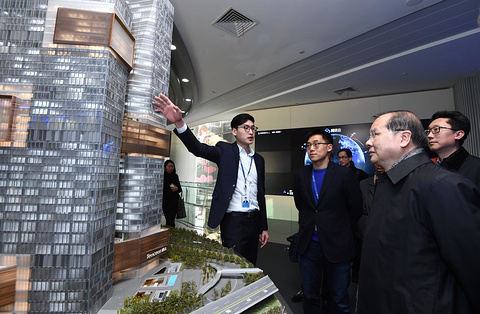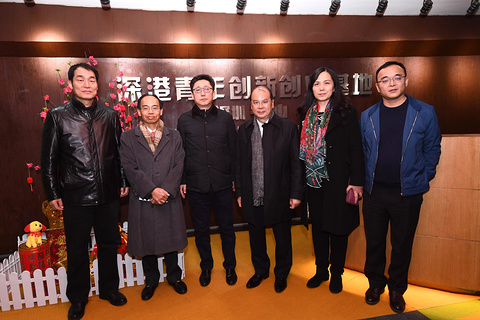Joint Development, Shared Prosperity
27 May 2018
In the mid-1980s, I served as the District Officer (North) and the district comprised Fanling, Sheung Shui, Sha Tau Kok and Ta Kwu Ling in the New Territories. During my tenure, I witnessed the rapid development of Shenzhen, a then newly-established special economic zone just a river away from Hong Kong. I still remember attending cross-boundary working meetings in Shenzhen where there were occasional power failures owing to inadequate supply in those days.
 |
That was the time when our country entered the initial stage of opening up, introducing economic reforms and moving towards marketisation and modernisation. Quite a number of Hong Kong manufacturers started to invest in factories in the Pearl River Delta Region, fully leveraging and maximising the complementary advantages of the two places.
Today, Shenzhen has been transformed into a modernised city, a major innovation and technology hub and an exemplary zone showcasing the fruits of reform and opening up.
Since opening up to the world in 1978, our country has entered a new era of tremendous economic growth. China has now become the world’s second largest economy, the largest industrial country, the largest cargo trading nation and the largest holder of foreign exchange reserve. In 2017, the Mainland’s gross domestic product (GDP) exceeded Renminbi (RMB) 80 trillion, amounting to 15% of the world’s GDP. Nowadays, our country plays a key role in a wide variety of areas including political, economic and technological development on the international stage.
The last four decades saw our country’s remarkable achievements in economic development. In fact, Hong Kong always has a part to play in the process of the nation’s reform, opening up and modernisation. While Hong Kong has made historic contribution to its progress, our economy has benefited from its development in return. During the 40 years of economic boom, our country has collaborated with Hong Kong on an interactive basis and maintained a mutually beneficial and win-win relationship.
With rich experience in the international arena, Hong Kong has been the most vital link connecting our country to the global economy. We have provided a robust platform to attract overseas investments and help Mainland enterprises go global.
During the early days of our country’s reform and opening up, Hong Kong manufacturers already started to invest in the Mainland, the Pearl River Delta Region in particular, bringing in capital and technologies. Actively participating in the development process, Hong Kong enterprises set up factories in various Mainland provinces and cities. They not only brought in management experience, but also helped their Mainland counterparts establish international networks. Following the migration of local industrial operations to the Mainland, Hong Kong has successfully transformed itself into a service-led economy.
In the 21st century, benefitting from national policy support, Hong Kong has reinforced and enhanced its status as an international financial centre, and established itself as the largest offshore RMB business centre in the world. It also continues to serve as a bridge linking the Mainland and international markets.
 |
 |
Through reform and opening up, our country has made big strides forward: from managing to stand on its feet to becoming prosperous and strong. It is by no means a small achievement. Take Shenzhen as an example: with rapid development, it now has a GDP comparable with that of Hong Kong.
Since the reform and opening up, the real GDP of the Mainland has grown by 34 times. The per capita GDP of Hong Kong in US dollars has also increased by 11 times, reaching US$46,200 last year and exceeding those of advanced economies such as Germany, the United Kingdom and Japan. In the recent decade, the average economic growth rate of Hong Kong has remained at 2.7%, more than double those of other advanced economies. Meanwhile, the total value of trade in goods of the Mainland has grown by 198 times, and that of Hong Kong’s exports has substantially increased by 71 times. Hong Kong has made significant contribution to the reform and opening up of our country’s development, which in return has helped shape Hong Kong as an international metropolis.
Just like President XI Jinping has said, the door of our country’s reform and opening up will not close. Rather, it will only open even wider. History tells us that openness leads to progress while seclusion certainly causes a country to lag behind. I believe that the development of the Guangdong-Hong Kong-Macao Bay Area (Bay Area) together with the Belt and Road Initiative will mark a new milestone in the history of our country’s reform and opening up, and will create enormous opportunities that Hong Kong should not miss.
As an old Chinese saying goes, “proximity gives you an edge”. Hong Kong should make good use of our existing advantages while seizing fresh openings in the new era. After our country’s 40 years of reform efforts, it is an opportune time for Hong Kong to review and clearly determine its positioning in the context of our country’s development strategy. Our endeavour to actively participate in the Bay Area development and the Belt and Road Initiative as a facilitator and a promoter will enable us to leverage our strengths to meet our country’s needs. “Joint development” and “shared prosperity” are certainly the twin goals that we should uphold and pursue.

